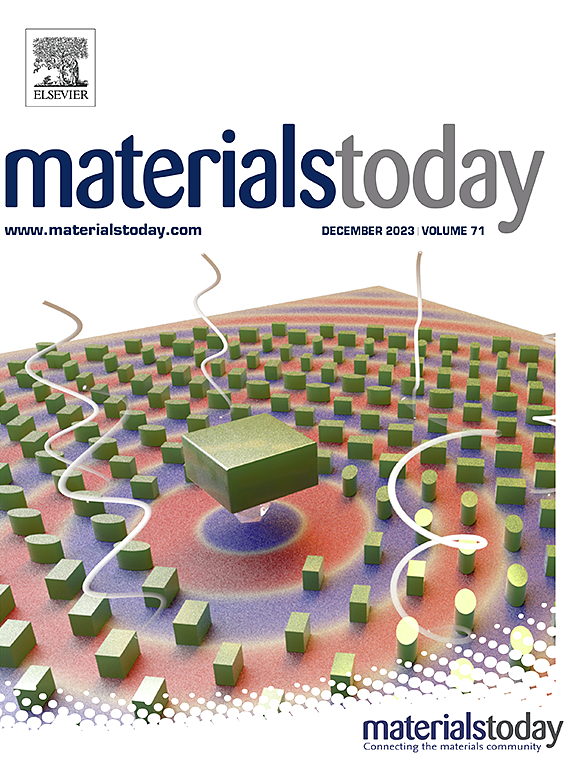Self-powered flexible electronic skin tactile sensor with 3D force detection
IF 21.1
1区 材料科学
Q1 MATERIALS SCIENCE, MULTIDISCIPLINARY
引用次数: 0
Abstract
Flexible and biocompatible self-driven sensors capable of multimodal perception are pivotal for the rapid development of wearable electronic devices. Currently, few studies have integrated the sensing of both frictional force and vertical pressure into a single, self-driven flexible sensor. Herein, we developed an acrylate (AA)-polyglutamic acid (PGA) hydrogel material that exhibits mechanical properties similar to those of skin. By integrating a triboelectric nanogenerator (TENG) into the AA-PGA hydrogel matrix, we constructed a dual-mode flexible sensor capable of utilizing biomechanical energy for multidirectional force sensing. This sensor features high sensitivity, high linearity, fast response, and excellent stability. A prototype was proposed for a robotic hand e-skin monitoring and analysis system to demonstrate the performance of the AA-PGA hydrogel sensor. As a self-driven sensor, the AA-PGA hydrogel sensor can perform real-time monitoring of physiological signals, such as wrist pulse detection and voice recognition. Moreover, it was continuously showcased in a series of personalized monitoring scenarios, including handwriting, step counting, and respiratory monitoring, further substantiating its outstanding sensing capabilities. Given these advantages, the developed AA-PGA hydrogel sensor holds great promise for applications in wearable sensors, physiological monitoring, and human–machine interfaces.

具有3D力检测的自供电柔性电子皮肤触觉传感器
具有多模态感知能力的柔性和生物相容性自驱动传感器是可穿戴电子设备快速发展的关键。目前,很少有研究将摩擦力和垂直压力的传感集成到一个单一的、自驱动的柔性传感器中。在此,我们开发了一种丙烯酸酯(AA)-聚谷氨酸(PGA)水凝胶材料,其机械性能与皮肤相似。通过将摩擦电纳米发电机(TENG)集成到AA-PGA水凝胶基质中,我们构建了一个能够利用生物机械能进行多向力传感的双模柔性传感器。该传感器具有灵敏度高、线性度高、响应快、稳定性好等特点。为验证AA-PGA水凝胶传感器的性能,提出了一种机器人手部电子皮肤监测与分析系统的原型。AA-PGA水凝胶传感器是一种自驱动传感器,可以对腕部脉搏检测、语音识别等生理信号进行实时监测。此外,它还在手写、步数、呼吸监测等一系列个性化监测场景中不断展示,进一步证明了其出色的传感能力。鉴于这些优点,所开发的AA-PGA水凝胶传感器在可穿戴传感器、生理监测和人机界面方面的应用前景广阔。
本文章由计算机程序翻译,如有差异,请以英文原文为准。
求助全文
约1分钟内获得全文
求助全文
来源期刊

Materials Today
工程技术-材料科学:综合
CiteScore
36.30
自引率
1.20%
发文量
237
审稿时长
23 days
期刊介绍:
Materials Today is the leading journal in the Materials Today family, focusing on the latest and most impactful work in the materials science community. With a reputation for excellence in news and reviews, the journal has now expanded its coverage to include original research and aims to be at the forefront of the field.
We welcome comprehensive articles, short communications, and review articles from established leaders in the rapidly evolving fields of materials science and related disciplines. We strive to provide authors with rigorous peer review, fast publication, and maximum exposure for their work. While we only accept the most significant manuscripts, our speedy evaluation process ensures that there are no unnecessary publication delays.
文献相关原料
公司名称
产品信息
上海源叶
Poly(γ-glutamic acid)
 求助内容:
求助内容: 应助结果提醒方式:
应助结果提醒方式:


